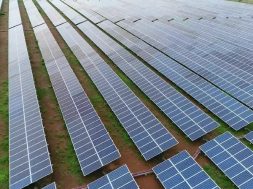
Adani to invest Rs 2 lakh cr in renewable energy capacity addition by 2030 – EQ
In Short : Adani Group plans to invest ₹2 lakh crore in expanding its renewable energy capacity by 2030. This substantial investment aligns with the group’s commitment to sustainability and aims to significantly increase its contribution to India’s clean energy sector.
In Detail : Ahmedabad : Adani group is looking to invest about Rs 2 lakh crore by 2030 to build 40 gigawatts of renewable energy generation capacity, as it targets net zero emissions across businesses by 2050, top officials said on Tuesday.
The apple-to-airport conglomerate currently has over 10 GW of capacity to generate electricity from renewable sources like sunlight and wind energy and is looking to add 6-7 GW every year to reach 50 GW by 2030.
“Considering the ballpark number of Rs 5 crore per megawatt, the investment could be in the range of Rs 2 lakh crore by 2030,” Adani Green Energy Ltd Executive Director Sagar Adani told reporters here.
Its CEO Amit Singh said the company would also build a 5 GW pump storage capacity to peak power demand during the night when sunlight is not available, and wind intensity is not strong enough to turn wind turbines to produce electricity. The carbon credits renewable capacity generates, together with a few other measures, will help turn the group net zero by 2050.
AGEL added 2.8 GW capacity in the 2023-2024 (April 2023 to March 2024) fiscal, which was 15 per cent of India’s total renewable energy capacity addition, Singh said.
“This year, our target is 6 GW,” he said.
Going forward, that kind of capacity addition or higher is likely every year, Adani said, adding that 80 per cent of the 50 GW capacity will be solar and the rest wind.
The conglomerate is building factories to make wafers used in solar panels to generate electricity and wind turbines.
Singh said the group is now looking at making 3 MW wind turbines for areas with lower wind speeds.
It currently makes wind turbines of 5.2 MW capacity that are suited for high-potential areas like Khavada in Gujarat.
India is the world’s third-largest economy in terms of energy needs, and its energy demand is projected to surge 25-35 per cent by 2030. Its peak energy demand is estimated to be 366.4 GW by 2031-32.
AGEL brought on a stream of 2,848 MW (2.8 GW) renewables capacity, the largest greenfield expansion in India’s renewable energy sector. This included 2,418 MW solar and 430 MW wind projects.
Of the capacity commissioned in FY24 includes 2,000 MW of solar capacity from Adani Green Energy’s World’s largest renewable energy project of 30,000 MW, being built at Khavda, Gujarat. The project is spread across 538 square kilometres, almost five times the city of Paris. Once built, it will be the largest power plant in the world, regardless of the energy source.
AGEL is also targeting the addition of at least 5,000 MW pumped storage project (PSP) capacity by 2030 in the first phase, Singh said. It has begun the construction of the first 500 MW PSP in Andhra Pradesh. The company has a robust development pipeline of hydro-pumped storage projects across Andhra Pradesh, Maharashtra, Tamil Nadu and Telangana.
With this, AGEL has revised its renewable energy target to 50,000 MW from 45,000 MW by 2030.
AGEL’s current operational portfolio is 10,934 MW, which consists of 7,393 MW solar, 1,401 MW wind and 2,140 MW wind-solar hybrid capacity. It is the first company in India to surpass the 10,000 MW renewable energy capacity.
Over the past five years, its operational capacity addition has outpaced the industry, achieving a CAGR of 41 per cent compared to India’s 13 per cent.
AGEL’s total locked-in portfolio stands at 21,953 MW (10,934 MW is operational, and 11,019 MW is under execution).
About 93 per cent of AGEL’s portfolio comprising 20,368 MW is now backed by 25-year fixed tariff PPAs with sovereign/sovereign equivalent counterparties, which gives it revenue predictability, and 7 per cent is merchant portfolio, offering higher realisations.











